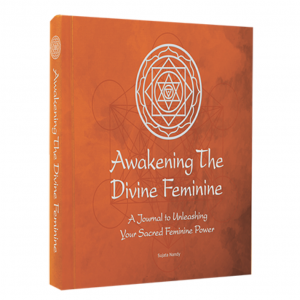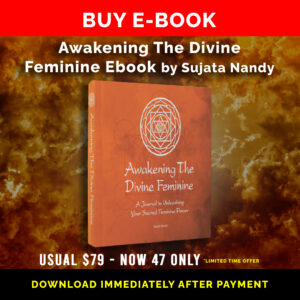Devi Siddhidatri is the ninth form of Navdurga and is worshipped on the ninth or final day of Navratri Pooja. In Sanskrit ‘Siddhi,’ means perfection and the divine Goddess is revered to seek all types of Siddhi. The grace of Devi Siddhidatri can put an end to greediness and help to control and satisfy the desires of her devotees.
Goddess Siddhidatri is represented draped in a red saree with a golden complexion. She is depicted with four arms and sitting on a pink lotus flower. She holds a mace in Her upper right hand and a chakra (discus) in Her lower hand. She holds a lotus flower and a white conch in Her upper and lower left hands respectively. Her procession is the lion.
‘Siddhi,’ means supernatural powers or meditative ability, and ‘Dhatri,’ means giver or awarder. It is believed that by worshipping Maa Siddhidatri, it is possible to achieve the eight siddhis, which are as follows: Anima, Mahima, Garima, Laghima, Prapti, Prakyamya, Inshitva and Vashitva. She is known to bestow Siddhis (the Mystical powers) to a plethora of beings like Gandharvas, Yakshas, Devas, Danavas, and Naras.
She is widely worshipped by Siddhas who undergo immense yogic practices by doing meditation and other ascetic practices to obtain several Siddhis, which is not an easy task, as the devotee must undergo several phases to invoke the spiritual powers within them.
The Goddess Siddhidhatri is not only known to grant wishes to siddhis, ascetics, or sages, but is also known to show Her ultimate compassion when a devotee meditates upon Her wholeheartedly. It was believed that worshipping this goddess helps to develop the art of perfection within oneself as well as in removing their ignorance.
According to Devi Bhagavatam, Lord Shiva had attained all the 18 siddhi’s from Goddess Siddhidhatri.
WHAT ARE THE 8 SIDDHIS?
In Hinduism, Siddhis
(Sanskrit: siddhi; fulfillment, accomplishment) are material, paranormal, supernatural, or otherwise magical powers, abilities, and attainments that are the products of yogic advancement through sādhanās such as meditation and yoga.
1) Anima
This is the ability to shrink one’s body size, even to the size of an atom. Becoming smaller than the smallest was described in Srimad Bhagavatam by Lord Krishna.
A common example of anima is when Lord Hanuman reduced His size when searching for Sita in Sri Lanka.
2) Mahima
The complete opposite of Anima, Mahima is becoming larger than the largest – as also described by Lord Krishna in Srimad Bhagavatam.
Lord Hanuman also assumed this form to set Lanka ablaze, and to fight Kumbha Karna.
3) Garima
This is the ability to become very heavy by will, that one is rendered immovable by anyone, or anything.
This is documented when Lord Hanuman made His tail so heavy that even the extremely strong Bhima couldn’t lift it.
4) Laghima
Laghima originates from the root word “laghu,” which means small, or light. This siddhi can make one’s body also weightless. Levitation and flying are the extended powers of this siddhi.
5) Prapti
This is the ability to obtain anything, anywhere. We might have read in the Hindu scriptures, or watched in mythical-themed shows, the Gods materialising things out of thin air – thanks to prapti siddhi.
6) Prakamya
The ability to obtain anything desired, and realising dreams. It is also the powers that enables one to live in water, and the power to enter the body of another person. For example, Sri Sankara entered the body of Raja Aamruka of Benares, and Tirumoolar entered the body of a sheperd using this siddhi.
7) Isitva
Referring to the “power of lordliness,” this siddhi is about power of absolute lordship over the entire creation. One of the greatest siddhis, Isitva enables crossing over the laws of nature and it overlaps the other siddhis. For example, this capable enables one to separate their soul from their body at will.
8) Vasitva
This is the ability to have anything under control, especially the physical manifestation of the five elements. This is the siddhi that can conquer any/or all beings in the universe.
The above-mentioned are the primary siddhis in the yoga tantric. Besides this, there 10 secondary siddhis, and thousands, and even millions of other siddhis according to Saivism and Vaishnavism.
It is believed that one side of Lord Shiva’s body is that of Goddess Siddhidatri. Therefore, He is also known by the name of Ardhanarishwar.
According to Vedic scriptures, Lord Shiva attained all the siddhis by worshiping this Goddess.
Offer the Devi pink flowers nuts and grains as prasad (food offerings), sweetmeats and 11 ghee lamps.
Meditate on Ganesha and offer prathana (obeisance) to the Goddess with deep devotion.
Ganesha Dhyanam
Vakratunda Mahakaya,
Suryakoti Samaprabha,
Nirvighnam Kurume Deva,
Sarva karyeshu Sarvada.
Prarthana (Obeisance)
Siddha Gandharva Yakshadyairasurairamarairapi।
Sevyamana Sada Bhuyat Siddhida Siddhidayini॥
Stuti (Salutations)
Ya Devi Sarvabhuteshu Maa Siddhidatri Rupena Samsthita।
Namastasyai Namastasyai Namastasyai Namo Namah॥
Dhyanam (Meditation)
Vande Vanchhita Manorathartha Chandrardhakritashekharam।
Kamalasthitam Chaturbhuja Siddhidatri Yashasvinim॥
Swarnavarnna Nirvanachakra Sthitam Navam Durga Trinetram।
Shankha, Chakra, Gada, Padmadharam Siddhidatri Bhajem॥
Patambara Paridhanam Mriduhasya Nanalankara Bhushitam।
Manjira, Hara, Keyura, Kinkini, Ratnakundala Manditam॥
Praphulla Vandana Pallavadharam Kanta Kapolam Pin Payodharam।
Kamaniyam Lavanyam Shrinakati Nimnanabhi Nitambanim॥
Stotra (Hymns)
Kanchanabha Shankhachakragadapadmadhara Mukatojvalo।
Smeramukhi Shivapatni Siddhidatri Namoastute॥
Patambara Paridhanam Nanalankara Bhushitam।
Nalisthitam Nalanarkshi Siddhidatri Namoastute॥
Paramanandamayi Devi Parabrahma Paramatma।
Paramashakti, Paramabhakti, Siddhidatri Namoastute॥
Vishvakarti, Vishvabharti, Vishvaharti, Vishvaprita।
Vishva Varchita, Vishvatita Siddhidatri Namoastute॥
Bhuktimuktikarini Bhaktakashtanivarini।
Bhavasagara Tarini Siddhidatri Namoastute॥
Dharmarthakama Pradayini Mahamoha Vinashinim।
Mokshadayini Siddhidayini Siddhidatri Namoastute॥
Kavacha (Armour)
Omkarah Patu Shirsho Maa, Aim Bijam Maa Hridayo।
Him Bijam Sadapatu Nabho Griho Cha Padayo॥
Lalata Karno Shrim Bijam Patu Klim Bijam Maa Netram Ghrano।
Kapola Chibuko Hasau Patu Jagatprasutyai Maa Sarvavadano॥
May you be abundant.
Jai Maa!
SUJATA NANDY WORLD GURUKUL
www.sujatanandy.com
Image credit: Pinterest







